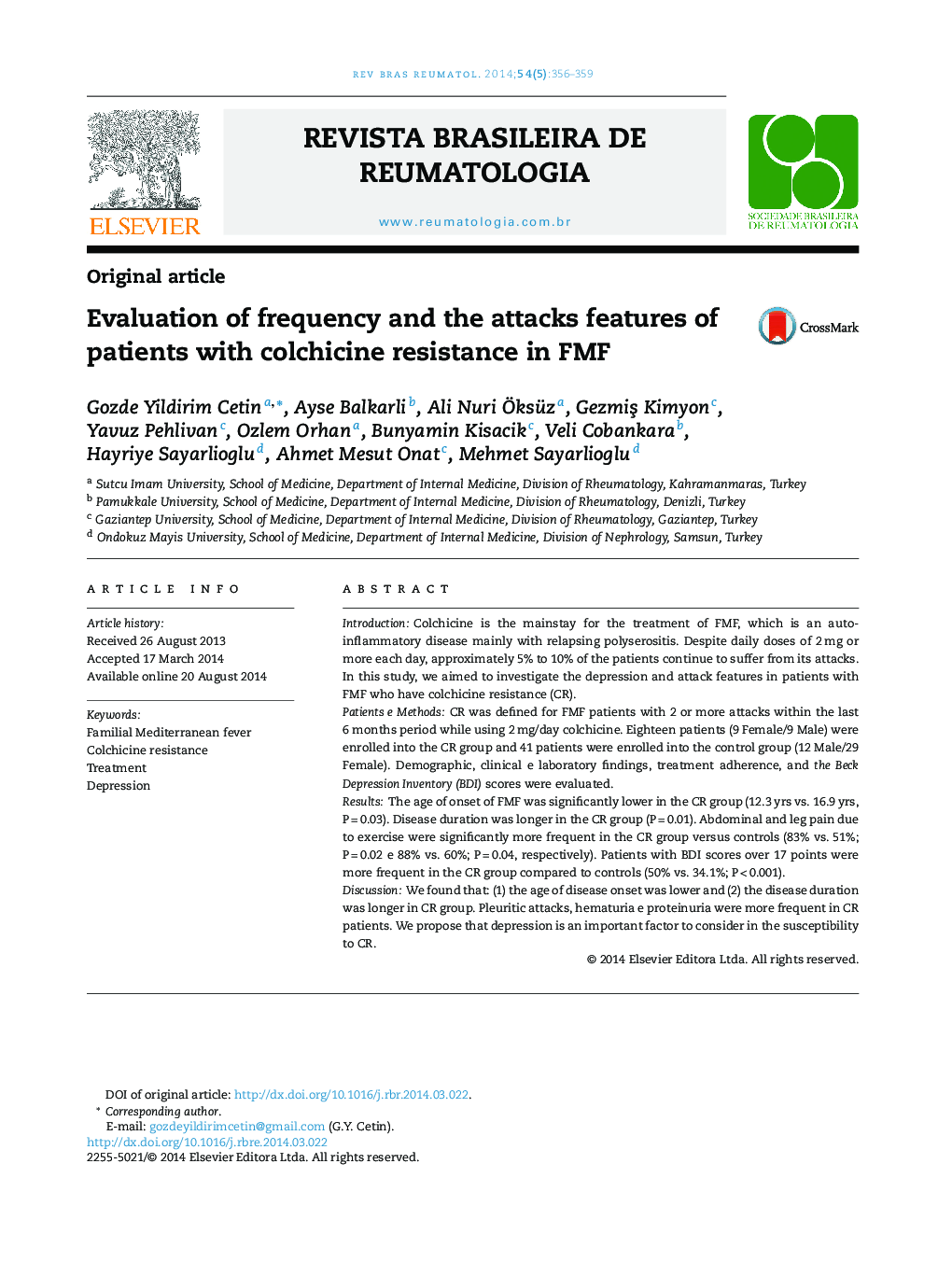| کد مقاله | کد نشریه | سال انتشار | مقاله انگلیسی | نسخه تمام متن |
|---|---|---|---|---|
| 3385129 | 1220574 | 2014 | 4 صفحه PDF | دانلود رایگان |

IntroductionColchicine is the mainstay for the treatment of FMF, which is an auto-inflammatory disease mainly with relapsing polyserositis. Despite daily doses of 2 mg or more each day, approximately 5% to 10% of the patients continue to suffer from its attacks. In this study, we aimed to investigate the depression and attack features in patients with FMF who have colchicine resistance (CR).Patients e MethodsCR was defined for FMF patients with 2 or more attacks within the last 6 months period while using 2 mg/day colchicine. Eighteen patients (9 Female/9 Male) were enrolled into the CR group and 41 patients were enrolled into the control group (12 Male/29 Female). Demographic, clinical e laboratory findings, treatment adherence, and the Beck Depression Inventory (BDI) scores were evaluated.ResultsThe age of onset of FMF was significantly lower in the CR group (12.3 yrs vs. 16.9 yrs, P = 0.03). Disease duration was longer in the CR group (P = 0.01). Abdominal and leg pain due to exercise were significantly more frequent in the CR group versus controls (83% vs. 51%; P = 0.02 e 88% vs. 60%; P = 0.04, respectively). Patients with BDI scores over 17 points were more frequent in the CR group compared to controls (50% vs. 34.1%; P < 0.001).DiscussionWe found that: (1) the age of disease onset was lower and (2) the disease duration was longer in CR group. Pleuritic attacks, hematuria e proteinuria were more frequent in CR patients. We propose that depression is an important factor to consider in the susceptibility to CR.
ResumoIntroduçãoColchicina é a viga-mestra para o tratamento de FFM, que é uma doença autoinflamatória com polisserosite recidivante como principal manifestação. Apesar de doses diárias de 2 mg ou mais/dia, aproximadamente 5%-10% dos pacientes continuam a sofrer de seus ataques. Neste estudo, objetivamos investigar os aspectos da depressão e dos ataques em pacientes com FFM apresentando resistência à colchicina (RC).Pacientes e MétodosEm pacientes com FFM, RC foi definida como dois ou mais ataques nos últimos seis meses, quando em medicação com colchicina 2 mg/dia. Dezoito pacientes (nove mulheres e nove homens) foram recrutados no grupo RC e 41 pacientes no grupo de controle (29 mulheres/12 homens). Foram avaliados os achados demográficos, clínicos e laboratoriais, a fidelidade ao tratamento e os escores do Beck Depression Inventory (BDI).ResultadosA idade de surgimento da FFM foi significativamente menor no grupo RC (12,3 anos vs. 16,9 anos, P = 0,03). A duração da doença foi maior no grupo RC (p = 0,01). Dores abdominais e nas pernas em decorrência do exercício foram significativamente mais frequentes no grupo RC versus controles (83% vs. 51%; p = 0,02 e 88% vs. 60%; p = 0,04, respectivamente). Pacientes com escores BDI > 17 pontos foram mais frequentes no grupo RC versus controles (50% vs. 34,1%; p < 0,001).DiscussãoVerificamos que: (1) a idade do surgimento da doença foi mais baixa e (2) a duração da doença foi maior no grupo RC. Ataques pleuríticos, hematúria e proteinúria foram mais frequentes em pacientes com RC. Propomos que a depressão é fator importante a ser levado em consideração na sensibilidade à RC.
Journal: Revista Brasileira de Reumatologia (English Edition) - Volume 54, Issue 5, September–October 2014, Pages 356–359